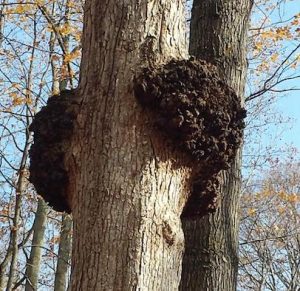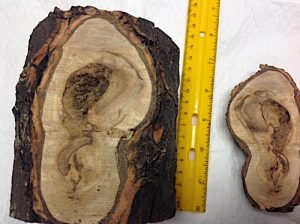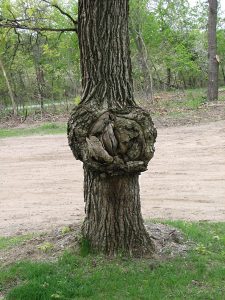Burls: Beauty in the Beast
By Margaret Klein Wilson, Fairfax Master Gardener Intern

Burls
The austere beauty of November goes beyond a change in color in the landscape. Once the foliage is past and fallen, the size and shape of things is easier to see and appreciate. Ridgelines, glacial erratics, tree shapes and those curious shapes on trees, aka burls. Bulbous, puckery and protruding, they conjure up images of scary cartoons, dark fairy tales and movies with talking trees. They remind me of gargoyles, and with as much personality as their granite cathedral counterparts.
Most sources cannot verify the why and how of burls. Plant scientists, arborists and woodturners who observe and work with burls admit they do not know if the source of a burl is a virus, insect or a bacterium.

Inside a maple burl
How is a burl formed? Although the “why” of a burl may be ambiguous, the “how” can be explained. Kevin Smith, PhD, plant physiologist for the USDA Forest Service, describes it this way: “The burl forms as a result of abnormal growth of xylem which is the cambium tissue in plants that allows water and nutrients to travel up from the roots. When the xylem begins growing abnormally in that part of the tree, it alters growth hormones, which allows the growths to develop more rapidly in that specific area than in the rest of the tree. Thus, the grain of the wood swirls densely around each bud trace, creating unique flowing grain patterns in the wood.”
Finding the beauty in the beast. Despite their often unattractive natural characteristics, burls, in the hands of an experienced woodturner, sculptor or artist, are transformed into singular works of art, reflecting the imprimatur of the artist and the beauty of the burl wood. Redwood, cherry, ash, walnut, buckeye, maple, bald cypress and oak burl wood are preferred by artists and consumers for their color and exaggerated grain patterning. The types and price range of goods created from burl wood are simply staggering, as any web search will confirm. Burl wood stock is protected in some states. Poaching burl wood can be an issue, especially redwood burls.
Little research will confirm the cause (or causes) of burls. This is perhaps because burls do not pose a threat to the health of trees, or to the financial interests of the forest industry. While the “why” of burls is not universally known, the guidelines of how to manage a tree with burls is generally agreed upon.

Basswood/Linden burl
Admire burls and leave them in place if the tree is healthy; a trunk burl is not likely to compromise the tree. If the burl is on a limb, and of an overwhelming size, the limb should be removed, and the wound treated. Sprouts growing out of a burl are safe to prune away. Burl removal from the main trunk, however, will open the tree to infection and stem decay, as wood wounds often take years to close completely.
If a burl-bearing tree is unhealthy and poses a risk to other property, consult with an arborist for removal of the tree. Likewise, if the burl’s growth becomes too large and places stress on a tree. Before felling any burl-bearing tree, check with an arborist or local crafts council about finding a wood artist to re-home the burl in new and wondrous ways.
The next time you are out for a walk, keep an eye open for a burl … or two. Once you notice one, they seem to be everywhere, and they are very convenient trail markers.
Resources
• Burlwood, Nick Rosato, Northern Woodlands
• The Biology of Burls, Kevin T. Smith, “Bark,” Issue 3, Massachusetts Tree Wardens’ and Foresters’
Association
• Go Figure: How Tree Burls Grow, Joe Rankin, Northern Woodlands
• Burls, University of Maryland Extension
• Recognizing and Controlling a Tree Burl, Steve Nix, ThoughtCo.